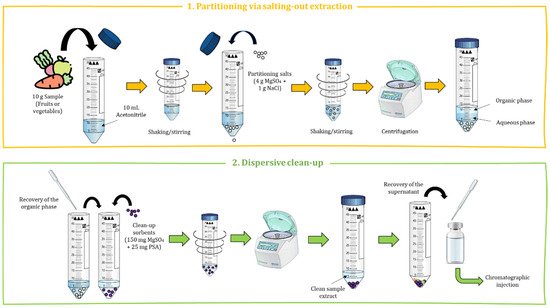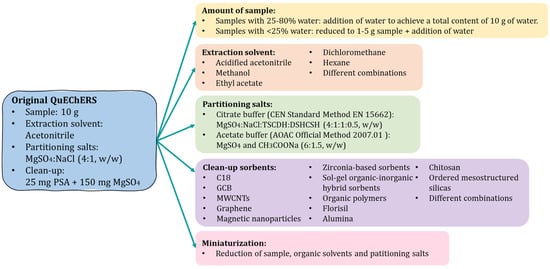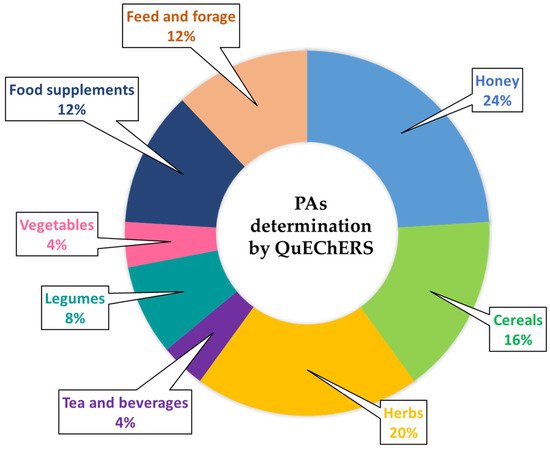The identification of concerning high levels of pyrrolizidine alkaloids (PAs) in a wide variety of food products has raised the occurrence of these natural toxins as one of the main current issues of the food safety field. Consequently, a regulation with maximum concentration levels of these alkaloids has recently been published to monitor their occurrence in several foodstuffs. According to legislation, the analytical methodologies developed for their determination must include multiresidue extractions with high selectivity and sensitivity, as a set of 21 + 14 PAs should be simultaneously monitored. However, the multiresidue extraction of these alkaloids is a difficult task due to the high complexity of food and feed samples. Accordingly, although solid-phase extraction is still the technique most widely used for sample preparation, the QuEChERS method can be a suitable alternative for the simultaneous determination of multiple analytes, providing green extraction and clean-up of samples in a quick and cost-effective way.
1. Introduction
In recent years, the awareness about natural toxins of plant origin in food and feed, such as pyrrolizidine alkaloids (PAs), has risen as one of the main issues of food safety. PAs are probably the most widely extended natural plant toxins, as more than 600 different chemical structures of these alkaloids have been identified from over more than 6000 plant species, being the main PA-producing plants belonging to the families Asteraceae, Fabaceae, Boraginaceae, Orchidaceae and Apocynaceae
[1]. In this sense, these alkaloids can be introduced into the food chain from different vegetables and botanical sources. In some cases, these PA-producing plants are directly consumed by animals (through forage) and humans (e.g., borage, salads, food supplements, teas and herbal infusions made of PAs producing plants, such as chamomile or rooibos, etc.). However, currently, the major sources of PA consumption in animal and humans seem to be feed and plant-derived products contaminated with PA-producing plants, as many of these plants grow in fields as weeds, leading to the contamination of food crops
[2][3][2,3]. Accordingly, several different contamination paths have been reported, such as cross-contamination during harvesting processes, natural horizontal transfer through soil, as well as food fraud and adulteration
[2][3][4][2,3,4]. As a consequence, many food alerts have notified in the last years high levels of these alkaloids in a wide variety of food products: spices and aromatic herbs (57% of the food alerts notified), teas and herbal teas (15% of the food alerts notified), food supplements (13% of the food alerts notified), herbs (8% of the food alerts notified), pollen (7% of the food alerts notified) and honey (1% of the food alerts notified)
[2][5][2,5]. Nonetheless, these alkaloids have also been detected in other plant-derived products, such as cereals, flours and salads, as well as in some animal-derived products such as milk and dairy products, eggs, meat and meat products
[2][6][7][8][9][2,6,7,8,9]. However, contamination of PAs in products of animal origin is less frequent, and the concentration levels found of these alkaloids are often low in this type of foodstuff. The intake of PAs represents a potential health risk, as they are known to produce both acute and chronic effects. In this sense, the ingestion of these alkaloids is mainly associated with liver damage (hepatic veno-occlusive disease (HVOD), liver cirrhosis and liver failure), but they can also produce genotoxic and carcinogenic effects at long-term exposure. Some of them (monocrotaline, riddelliine, and lasiocarpine) have been classified as potential carcinogens to humans (Group 2B) by the International Agency for Research on Cancer (IARC)
[10][11][12][13][10,11,12,13]. Therefore, due to the wide spread of these alkaloids in a large variety of food products and the potential health risk that their frequent intake may entail for consumers, the analytical control of these alkaloids in food and feed is of utmost importance and constitutes a matter of interest. For this reason, in December 2020, the European Commission published a regulation amending Regulation (EC) No. 1881/2006 to monitor the occurrence of PAs in some food products
[14]. This regulation sets maximum total concentration levels of PAs (ranging from 1.0 to 1000 μg/kg) in different foodstuffs, including: tea and herbal infusions, herbal food supplements, pollen-based food supplements, pollen, pollen products, dried herbs and cumin seeds
[14]. Moreover, according to this legislation, every analytical methodology used to monitor these contaminants in food or feed must include the analysis of 21 PAs (including their
N-oxide forms, PANOs). At the same time, 14 additional PAs can be considered if the chromatographic method employed enables the individual separation and identification of them without coelution problems, as they are isomers of one or more of the previous mentioned 21 PAs that are known to co-elute with some of them
[14]. The coelution of these isomers is one of the main issues in the analysis of PAs. Consequently, powerful and efficient methods are required to perform the determination of PAs, which must include multiresidue extraction with high selectivity and sensitivity, as well as being quick and environmentally friendly procedures. However, the multiresidue extraction of these natural toxins is a difficult task, as they can be subjected to multiple matrix interferences that hamper their extraction and identification due to the high complexity of food and feed samples. In this sense, the QuEChERS (acronym of quick, easy, cheap, effective, rugged and safe) strategy can be a suitable approach for the determination of multiple analytes at the same time, as it enables the simultaneous green extraction and clean-up of samples before their instrumental analysis by gas chromatography (GC) or liquid chromatography (LC)
[15][16][15,16].
The QuEChERS method was first proposed by Anastassiades et al. (2003)
[17] and afterward validated by Lehotay et al. (2005)
[18] for the simultaneous multiresidue extraction of a wide variety of pesticides (covering a broad range from non-polar to polar compounds) from fruit and vegetable samples. Since then, this method has gained great popularity, expanding its application range to other matrices and analytes due to its inherent advantages (quick, cheap, simple and user-friendly) and high throughput extraction efficiency
[15][16][15,16]. However, despite its multiple advantages and compliance with the green analytical chemistry (GAC) principles, this method has scarcely been applied in the determination of PAs in contrast with other extraction and purification conventional methods, such as solid-phase extraction (SPE)
[2][13][2,13]. In this sense, despite that conventional SPE requires more time and reagents to be performed, 58% of the published works that carry out the determination of PAs in food and feed samples used this technique, followed by 29% of works that apply the QuEChERS strategy, whereas only 13% of the articles only perform solid–liquid or liquid–liquid extraction (depending on the sample) without clean-up or purification steps (
Figure 1a). Nevertheless, a slight increase in the number of works published using QuEChERS for the determination of PAs has been observed in recent years (
Figure 1b). Although the general trend shows great fluctuations over the last 11 years in its application (
Figure 1b), it is expected that its increase will continue in the coming years.
Figure 1. (a) Overview of the main extraction methods used for pyrrolizidine alkaloids from food and feed, and (b) evolution of the number of published articles using QuEChERS for the determination of pyrrolizidine alkaloids in food and feed samples over the last 11 years (2011–2022). Data obtained from Scopus, Web of Science and Google search engines up to March 2022. LLE: liquid–liquid extraction; SLE: solid–liquid extraction; SPE: solid–phase extraction.
2. Basis of the QuEChERS Method
The QueChERS was designed as a multiresidue approach for the determination of multiple analytes (more than 200 pesticides) at the same time, involving simultaneous extraction and clean-up of samples (particularly, fruit and vegetables)
[17]. This method is based on the dispersion of salts (salting-out effect) to extract and isolate a wide variety of analytes from complex matrices in addition to the subsequent clean-up of the sample extract obtained. In this sense, there are two clear steps in this approach:
- (i)
-
Extraction step based on partitioning via salting-out extraction, achieving an equilibrium between an aqueous and an organic phase.
-
- (ii)
-
Clean-up step carried out by dispersive solid-phase extraction (dSPE) using different sorbent materials and salts to remove matrix interferences.
-
The original QuEChERS procedure involves using 10 g of sample, 10 mL of organic solvent (acetonitrile, ACN), 5 g of partitioning salts (4 g MgSO
4 and 1 g NaCl) and 175 mg of clean-up sorbents (25 mg primary secondary amine (PSA) and 150 mg MgSO
4)
[17]. Accordingly, the sample is first subjected to a solid–liquid extraction (SLE) with ACN carried out by manual shaking and followed by the salt partitioning step with MgSO
4 and NaCl to promote water partition from the organic layer and its dehydration. The addition of these salts enables a decrease in the solubility of polar compounds in the aqueous phase and removal of water from the organic phase. To achieve efficient and homogeneous interaction among the salts, the organic solvent and the sample, a stirring process followed by centrifugation is carried out, which allows for the separation of both phases. Afterward, an aliquot of the supernatant corresponding to the organic phase is recovered for the subsequent dSPE clean-up step. PSA is a weak anion exchange sorbent; thus, it can interact strongly with the acid matrix interferents that may have been co-extracted during the process, such as sugars, fatty acids and organic acids, promoting their elimination from the ACN phase. Conversely, the addition of MgSO
4 in the clean-up step removes the residual water content in the extract and improves the interaction of the above-mentioned matrix interferences on the PSA sorbent, leading to a final extract with less polarity due to the precipitation of the polar interferents which improves their retention in the PSA sorbent. After a brief shaking and centrifugation, the supernatant is recovered and can be directly analyzed by GC or LC
[15][16][17][18][15,16,17,18].
Figure 2 shows the schematic layout of the original QuEChERS procedure.
Figure 2.
Schematic layout of the original QuEChERS procedure with its two differentiated steps.
Nevertheless, since its origin, despite its high efficiency, the QuEChERS concept has evolved to be adapted to other analytes and matrices. In this sense, due to its flexibility, several modifications have been successfully introduced in its key parameters in order to improve its extraction efficiency, to spread its potential application to a wide range of matrices and to achieve simultaneous extraction of multiple compounds belonging to different chemical families
[15][16][15,16]. Some of the most notable modifications in the QuEChERS procedure are depicted in
Figure 3.
Figure 3. Most notable modifications of the original QuEChERS procedure. PSA: primary secondary amine; TSCDH: trisodium citrate dihydrate; DSHCSH: disodium hydrogen citrate sesquihydrate; C18: octadecylsilane, GCB: graphitized carbon black; MWCNTs: multiwalled carbon nanotubes.
3. Evolution of the Original QuEChERS Method and Its Application to the Determination of Pyrrolizidine Alkaloids in Food and Feed Samples
Table 1 summarizes the different QuEChERS strategies carried out within the last 11 years for the extraction and analysis of PAs and PANOs in different food and feed products. As it can be observed, this strategy has been mainly applied to the determination of PAs in honey samples, followed by the analysis of herb samples (highlighting oregano) and (herbal) teas (including both the dry product and the beverage) (Figure 4 and Table 1), likewise, its application to cereal samples, such as wheat, sorghum and quinoa. In contrast, to a lesser extent, it has been applied to the analysis of legumes (pea and soy) and vegetables (leek) (Table 1 and Figure 4). It has also been used in products employed as food supplements, such as pollen, and in feed and forage samples (Table 1 and Figure 4).
Figure 4. Overview of the different food and feed matrices used as samples for the determination of pyrrolizidine alkaloids by modified QuEChERS method over the last 11 years (2011–2022). Data obtained from Scopus, Web of Science and Google search engines up to March 2022.
Table 1.
Application of modified QuEChERS to the determination of pyrrolizidine alkaloids in food and feed samples.
Due to the multiple advantages of the QuEChERS method (simplicity, cost-effectiveness and ability to perform multiple extraction of different analytes), many of the works
reviewed carried out the simultaneous co-analysis of PAs with other compounds, such as other plant toxins (mainly tropane alkaloids, among others such as glycoalkaloids, isoquinoline alkaloids, ergot alkaloids, opium alkaloids, etc.), pesticides, mycotoxins, drugs, phytoestrogens, etc.
[19][23][29][30][31][32][33][34][35][19,23,29,30,31,32,33,34,35]. However, despite its advantageous properties, the QuEChERS procedure has been scarcely employed for the analysis of PAs compared to SPE, as previously mentioned (
Figure 1). Nonetheless, its application to the analysis of PAs is expected to increase significantly in the coming years, as it is quicker and more environmentally friendly than conventional SPE. In this context, Martinello et al. (2017) compared both types of extraction techniques for the analysis of nine PAs in honey samples, concluding that SPE, besides being more tedious and time-consuming than QuEChERS, also provided worse recovery values for the analytes
[19].
Conversely, some authors carried out a first extraction with H
2SO
4 followed by the addition of zinc dust prior to the QuEChERS method. This first step is performed with the aim of reducing the PANOs to their corresponding PAs form (which is their tertiary base form)
[19][20][34][19,20,34]. For this reason, in these works, only PAs are determined in the honey and pollen samples, while PANOs are not determined nor quantified. This reduction procedure is more indicated for the analysis of PAs by GC, as PANOs cannot be analyzed with this technique because they are unstable at the temperatures needed for volatilization
[2][37][38][2,37,38]. Therefore, as PAs and PANOs are both toxicologically important and both forms need to be included in the analytical determination of these alkaloids
[1][14][1,14], this reduction procedure can be carried out to ensure the extraction and determination of both types. However, in all the works
reviewed for the determination of PAs by QuEChERS extraction, none of them used GC for the instrumental analysis of the sample extracts obtained after the QuEChERS procedure (
Table 1). In contrast, all of them used LC coupled to tandem mass spectrometry (LC-MS/MS), which it is generally preferred over GC, as no derivatization of PAs is required; thus, sample preparation is easier and quicker
[2]. Moreover, LC-MS/MS achieves the individual detection and quantification of both PAs and PANOs. Therefore, one of the reasons to use the zinc reduction strategy with LC analysis may be the acquisition of less commercial standards to perform the total quantification of PAs, as it avoids acquiring commercial standards for PANOs
[2]. However, one drawback of this reduction procedure is that it does not perform individual analysis of PAs, and consequently, it is not possible to determine the contamination profile of PAs and PANOs in the samples or the origin of the contamination source. Moreover, the reduction step increases the time of the analytical method, as it requires 1 h and 30 min
[20], which makes the extraction process more tedious and time-consuming. Regarding the LC-MS/MS instrumental analysis of the works
reviewed, it is observed that all of them used electrospray ionization (ESI) in positive ion mode as ionization source (
Table 1). Nonetheless, some works also indicated the simultaneous determination in both positive and negative ion mode
[30][31][32][30,31,32]. However, the reason is that in these works, in addition to PAs, other compounds are also included in the chromatographic analysis, as previously indicated (e.g., plant toxins, mycotoxins, pesticides, phytoestrogens, etc.). Thus, the ionization in negative ion mode is employed for the identification of these other analytes. Additionally, most of the works
reviewed used multiple reaction monitoring (MRM) as detection mode (
Table 1), as it is common for all types of analytes when MS/MS is performed. In a lesser extent, other authors have used high resolution mass spectrometry (HRMS) as a detection mode (
Table 1), since they used a Q-Orbitrap as mass spectrometry analyzer, which is suitable for this type of detection. Moreover, in general, other compounds different from PAs are also simultaneously co-analyzed in the chromatographic method of these works. Therefore, the HRMS mode is suitable for this purpose, as it detects a high number of compounds with tentative analysis. Conversely, only one work carried out the analysis with selected ion monitoring (SIM) as detection mode, since a single quadrupole (Q) was used as a mass spectrometry analyzer for the detection
[20].
Regarding the QuEChERS method, it can be observed that none of the works published in the literature for the determination of PAs in food and feed have carried out the original QuEChERS procedure, since they all present one or more modifications (Table 1). Nonetheless, despite the modifications made, good extraction efficiency has been achieved for the extraction of PAs, as in general satisfactory recovery values have been achieved with adequate sensitivity (Table 1). Some of the most notable modifications in the QuEChERS procedure and their application to the determination of PAs are described below.




